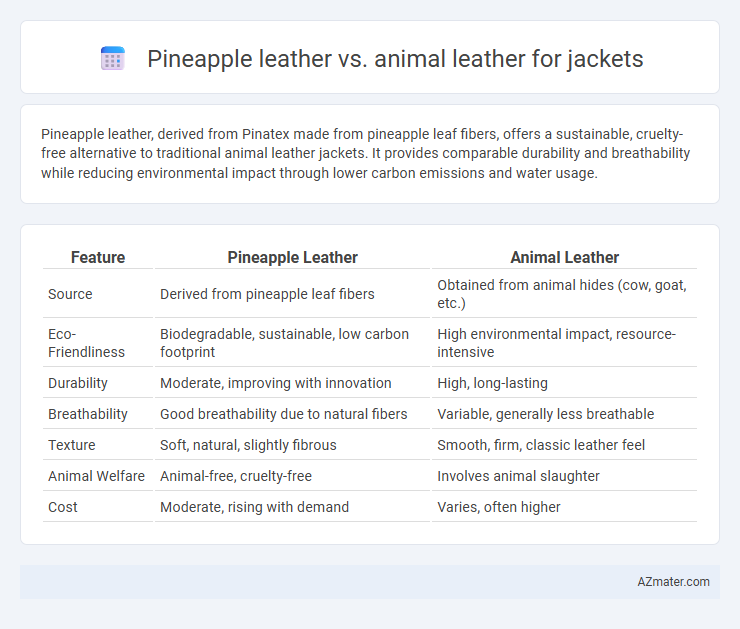Pineapple leather, derived from Pinatex made from pineapple leaf fibers, offers a sustainable, cruelty-free alternative to traditional animal leather jackets. It provides comparable durability and breathability while reducing environmental impact through lower carbon emissions and water usage.
Table of Comparison
| Feature | Pineapple Leather | Animal Leather |
|---|---|---|
| Source | Derived from pineapple leaf fibers | Obtained from animal hides (cow, goat, etc.) |
| Eco-Friendliness | Biodegradable, sustainable, low carbon footprint | High environmental impact, resource-intensive |
| Durability | Moderate, improving with innovation | High, long-lasting |
| Breathability | Good breathability due to natural fibers | Variable, generally less breathable |
| Texture | Soft, natural, slightly fibrous | Smooth, firm, classic leather feel |
| Animal Welfare | Animal-free, cruelty-free | Involves animal slaughter |
| Cost | Moderate, rising with demand | Varies, often higher |
Introduction: The Rise of Sustainable Leather Alternatives
Pineapple leather, derived from pineapple leaf fibers, offers a sustainable and eco-friendly alternative to traditional animal leather in jacket manufacturing. This plant-based material reduces environmental impact by utilizing agricultural waste and eliminating the need for animal farming and tanning processes. Consumers increasingly favor pineapple leather for its cruelty-free production, biodegradability, and comparable durability to conventional leather.
What Is Pineapple Leather?
Pineapple leather, also known as Pinatex, is an innovative sustainable material made from the cellulose fibers extracted from pineapple leaves, offering an eco-friendly alternative to traditional animal leather. This plant-based leather is biodegradable, requires less water, and eliminates the ethical concerns associated with animal farming, making it a popular choice for vegan and environmentally conscious fashion. Compared to animal leather, pineapple leather is lightweight, breathable, and possesses a unique texture, while maintaining durability suitable for stylish jackets.
How Is Animal Leather Produced?
Animal leather is produced through a process called tanning, which preserves animal hides by stabilizing the collagen fibers to prevent decomposition. The raw hides undergo stages including curing, soaking, liming, fleshing, tanning, and finishing, with chromium salts or vegetable tannins commonly used in tanning methods. This process transforms perishable skin into durable leather ideal for jackets, but involves significant water use and chemical treatments affecting environmental impact.
Environmental Impact: Pineapple Leather vs Animal Leather
Pineapple leather offers a sustainable alternative by utilizing agricultural waste from pineapple leaves, significantly reducing environmental pollution and deforestation compared to traditional animal leather. Animal leather production involves extensive water consumption, greenhouse gas emissions, and chemical tanning processes that contribute to soil and water contamination. Choosing pineapple leather for jackets supports lower carbon footprints and promotes eco-friendly fashion innovation.
Durability and Longevity Comparison
Pineapple leather, made from Pinatex fibers, offers notable durability with resistance to wear and water, but it typically has a shorter lifespan compared to traditional animal leather. Animal leather, especially full-grain varieties like cowhide, provides superior longevity, often lasting decades due to its natural toughness and ability to develop a protective patina over time. While pineapple leather suits eco-friendly fashion trends, animal leather remains the benchmark for jackets demanding maximum durability and long-term wear.
Comfort and Wearability: Which Feels Better?
Pineapple leather offers a lightweight, breathable texture that enhances comfort during extended wear, making it a popular vegan alternative for jackets. Animal leather excels in durability and molds to the body over time, providing a personalized fit and superior warmth. Comfort preferences vary, with pineapple leather favored for heat dissipation and animal leather prized for its long-term wearability and classic feel.
Aesthetic Differences: Appearance and Texture
Pineapple leather features a natural, fibrous texture with a matte finish, offering a unique, organic aesthetic distinct from the smooth, polished surface of animal leather. The irregular grain patterns in pineapple leather create a more rustic and artisanal look, while animal leather typically showcases consistent grain and a glossy sheen that emphasizes its luxurious appeal. Color variations in pineapple leather are often subtle and earthy, contrasting with the rich, deep tones and uniformity found in traditional animal leather jackets.
Cost Factors: Pineapple Leather vs Animal Leather Jackets
Pineapple leather jackets typically have higher production costs due to the innovative processing required to convert pineapple fibers into durable, eco-friendly material, resulting in prices often exceeding those of conventional animal leather jackets. Animal leather jackets benefit from established supply chains and economies of scale, making them generally more affordable but subject to ethical concerns and environmental costs. The price difference also reflects trends in consumer demand for sustainable fashion, with pineapple leather commanding a premium for its cruelty-free and biodegradable properties.
Ethical Considerations and Consumer Choices
Pineapple leather, made from sustainable pineapple leaf fibers, presents an ethical alternative to traditional animal leather by reducing environmental impact and addressing animal welfare concerns. Consumers seeking cruelty-free fashion increasingly prefer pineapple leather jackets due to its biodegradable and vegan-friendly properties. While animal leather offers durability, pineapple leather's lower carbon footprint and support for circular economy principles align with growing demands for responsible consumption.
Conclusion: Which Leather Is Best for Jackets?
Pineapple leather offers a sustainable, cruelty-free alternative to traditional animal leather, featuring durability and water resistance suitable for jackets. Animal leather remains favored for its natural breathability, longevity, and classic aesthetic but involves environmental and ethical concerns. For eco-conscious consumers seeking stylish, functional jackets, pineapple leather provides the best balance of sustainability and performance, while animal leather excels in heritage and texture quality.

Infographic: Pineapple leather vs Animal leather for Jacket
 azmater.com
azmater.com